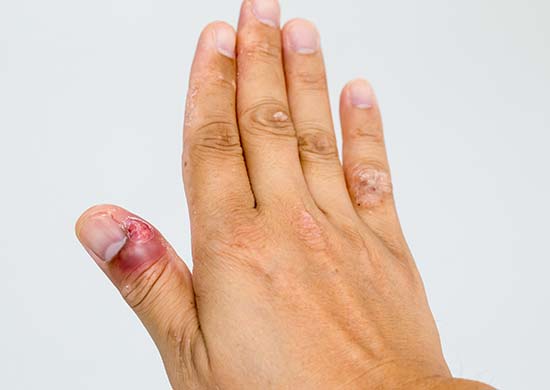About toenail infection and fingernail infection
Fingernail or toenail infections can be caused by fungus, bacteria or viruses.
Fungal nail infections happen when fungus gets into the nail through small cracks in the nail or surrounding skin. Fungal infection of the nail is called onychomycosis. It’s the most common type of nail infection.
Bacterial, viral or fungal infection often happens with ingrown toenails, which is when the toenail pierces the skin around it. This can cause inflammation of the skin around the nail. It’s called paronychia.
Children have a higher chance of getting nail infections if they:
- chew or bite their nails
- have type-1 diabetes or type-2 diabetes
- have a weakened immune system because of certain medicines or medical conditions
- have Down syndrome.
Nail infections are common in adults but are much less common in children.
Symptoms of toenail infection or fingernail infection
Fungal infections of the nail can make the nail thicken, crumble and change colour – usually to yellow or white. This often happens slowly, and it’s usually painless.
If the skin on the feet is affected, you might see a scaly rash.
Fungal infections affect the toenails more often than the fingernails.
If your child has a bacterial or viral infection, the skin around your child’s finger or toe will be inflamed. On children with dark skin, the inflammation might look brown, purple or grey. On children with light skin, the inflammation might look red. The skin might also be swollen, hot, tender and painful.
A blister with pus can form next to the nail. Rarely, your child might get a fever and have difficulty moving their finger or toe.
Bacterial and viral infections affect the fingernails more often than the toenails.

Medical help: when to get it for children and teenagers with a toenail infection or fingernail infection
Take your child to your GP if your child has any of the symptoms described above, especially if there’s pus around your child’s toenail or fingernail, or your child is in pain.
It’s also important to see your GP if your child keeps getting nail infections. This might be a sign of an underlying illness.
Treatment for toenail infection or fingernail infection
For fungal nail infections, your GP will prescribe antifungal medicine. Your GP might take a clipping of the nail before treatment starts to check that the cause is fungus.
For mild bacterial or viral infections with no pus, clean the affected finger or toe with an antiseptic solution. If your GP has prescribed an antibiotic cream, put it on the affected area.
When there’s pus around the nail, your child will probably need oral antibiotics from your GP. The GP might also want to drain the pus from the nail area.
Try to keep the infected area clean. Your GP might tell you to cover the area with a basic dressing, which you can get from a pharmacy.
If your child is in pain, it might help to put something warm on the area. You could try a heat pack. You can also give your child pain medicine like paracetamol or ibuprofen according to the directions on the packet.
Children with a severe bacterial infection might need antibiotics directly into a vein through a drip and the nail might need to be removed.
After you’ve touched or dressed your child’s nail infection, you should always wash your hands thoroughly.
Preventing toenail infection or fingernail infection
To prevent fingernail and toenail infection, your child should avoid:
- biting or pulling off broken nails or hangnails
- sucking their fingers or toes
- trimming their nails too hard or close
- wearing shoes that are too tight around the nails.
Your child should also dry their hands and feet properly if they get wet or sweaty. And it’s best for your child to see your GP or a podiatrist if they get an ingrown toenail.
If your child has diabetes, well-controlled blood sugar levels will help to prevent infections.